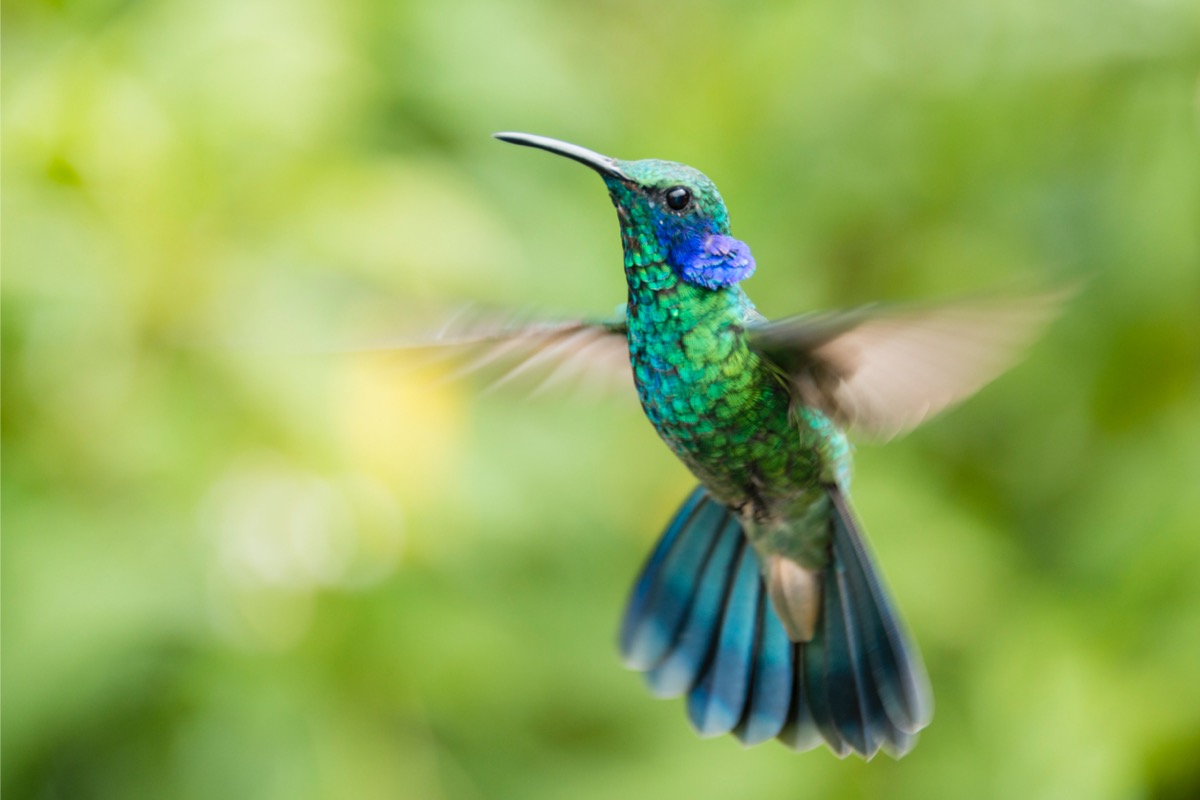

We may earn revenue from the products available on this page and participate in affiliate programs. Learn More ›
How many species of hummingbirds are there? More than 330 hummingbird species live in the Western Hemisphere. A couple dozen hummingbird types migrate to the U.S. in the spring to breed—to the delight of birdwatchers.
When identifying these birds, a complex question to answer is, “What color are hummingbirds?” Many hummingbirds feature vibrant hues of blue, green, red-orange, and magenta, colors that are visible thanks to complicated pigmentation structures in their feathers.
Hummingbird sizes range from under 3 inches to around 5 inches long. The world’s tiniest birds are fascinating creatures who can fly at speeds above 30 miles per hour, their wings flapping from 10 to 80 times per second. While in full flight, their hearts can beat up to 1,260 times per minute.
To assist with hummingbird identification, here are 23 different types of hummingbirds to be on the lookout for around your backyard hummingbird feeder or when traveling throughout North America.
1. Broad-Tailed Hummingbird
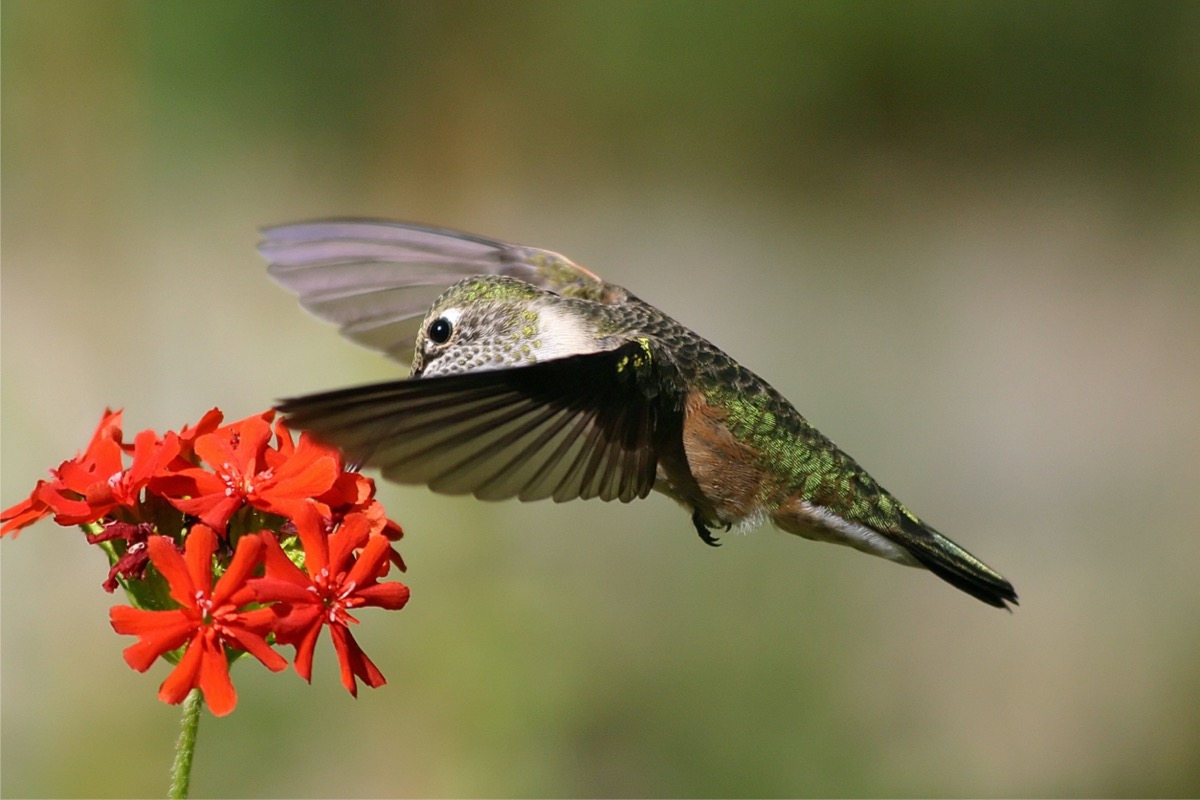
Often confused with the ruby-throated hummingbird, the broad-tailed hummingbird has some distinguishing marks that help identify it. Males exhibit a rosy-red or pinkish gorget; females have a spotted throat. Both have a spotted white chin. Males have a thin white line through their eye and females have a faint eye ring. Their tails are long and rounded, with rufous edging. You might be able to hear a zinging metallic trill from their wings when they fly.
Key Characteristics: Broad-tailed hummingbirds are typically about 4 to 4¼ inches long and can be easily identified by their rosy-red/pinkish throats.
Habitat Range: The broad-tailed hummingbird can be seen from the Western mountains in the U.S. to Central America. Unlike the ruby-throated hummingbird, this hummer rarely travels further east.
2. Allen’s Hummingbird
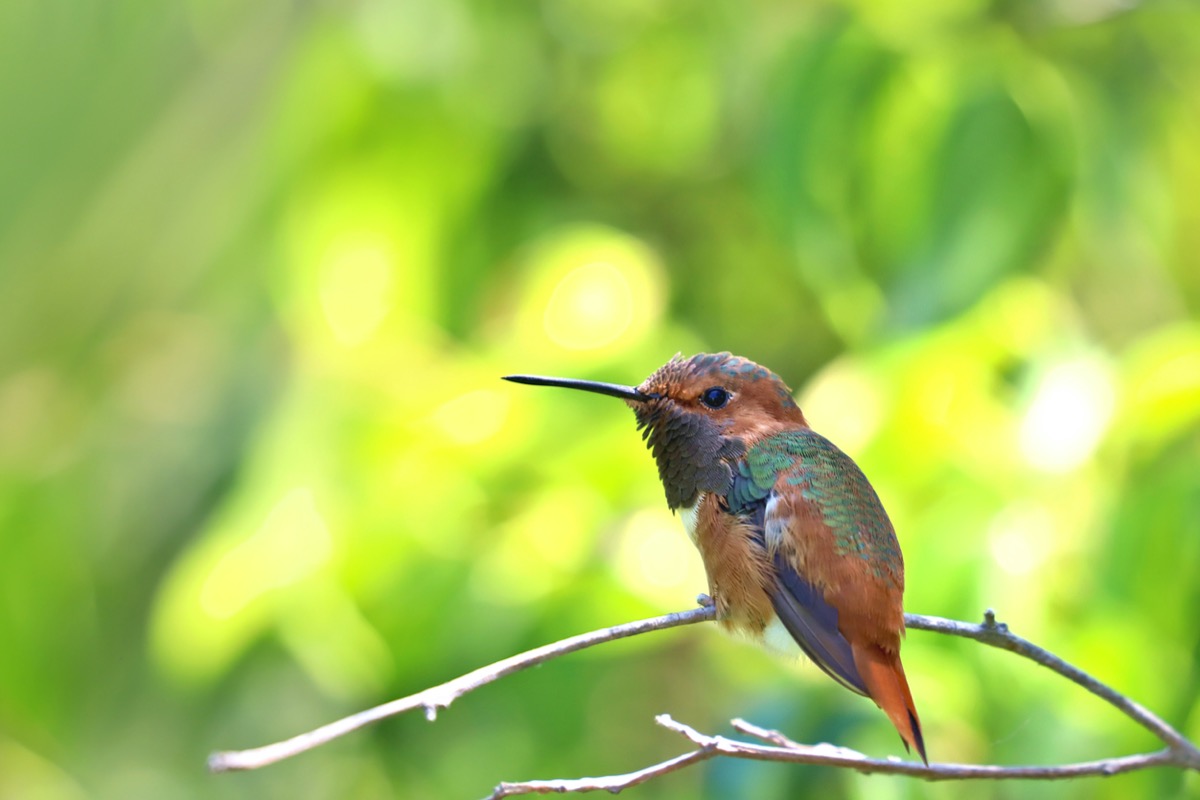
Seen along the California coast and up to Southern Oregon, Allen’s hummingbirds are small and stocky (about 3½ inches long), with straight bills as long as their heads. Males feature a bronze-green back, with a deep red-orange gorget and a coppery tail, eye patch, and belly. Females feature paler colors, with more spots and a small patch of red-orange on their throats. When perched, their tails extend past their wings. Males will display by flying side to side, their wings making a bumblebee-type of buzz.
Key Characteristics: This is a stocky hummingbird with bronze and green coloring, though females feature paler hues, and straight bill.
Habitat Range: Allen’s hummingbirds breed in areas of coastal forest, scrub, and chaparral along the Western coast as far north as Southern Oregon.
RELATED: How to Make Hummingbird Food
3. Black-Chinned Hummingbird

Despite its name, the black-chinned hummingbird is mostly identified by the iridescent purple band and white collar on its throat. Males feature a green or gray-green head, back, and flanks, with a white spot behind the eye. Their tails have a noticeable fork. Females are similarly colored, but their throats may have green streaks and the corners of their tails are white.
This 3½-inch bird doesn’t sing; it produces a rapidly repeated low whistle-like sound instead. These hummers visit backyard hummingbird feeders and usually build nests 10 feet or less above the ground.
Key Characteristics: Look for the iridescent purple throat to identify the black-chinned hummingbird.
Habitat Range: They migrate to Central Mexico from the West Coast to the Gulf Coast.
4. Violet-Crowned Hummingbird
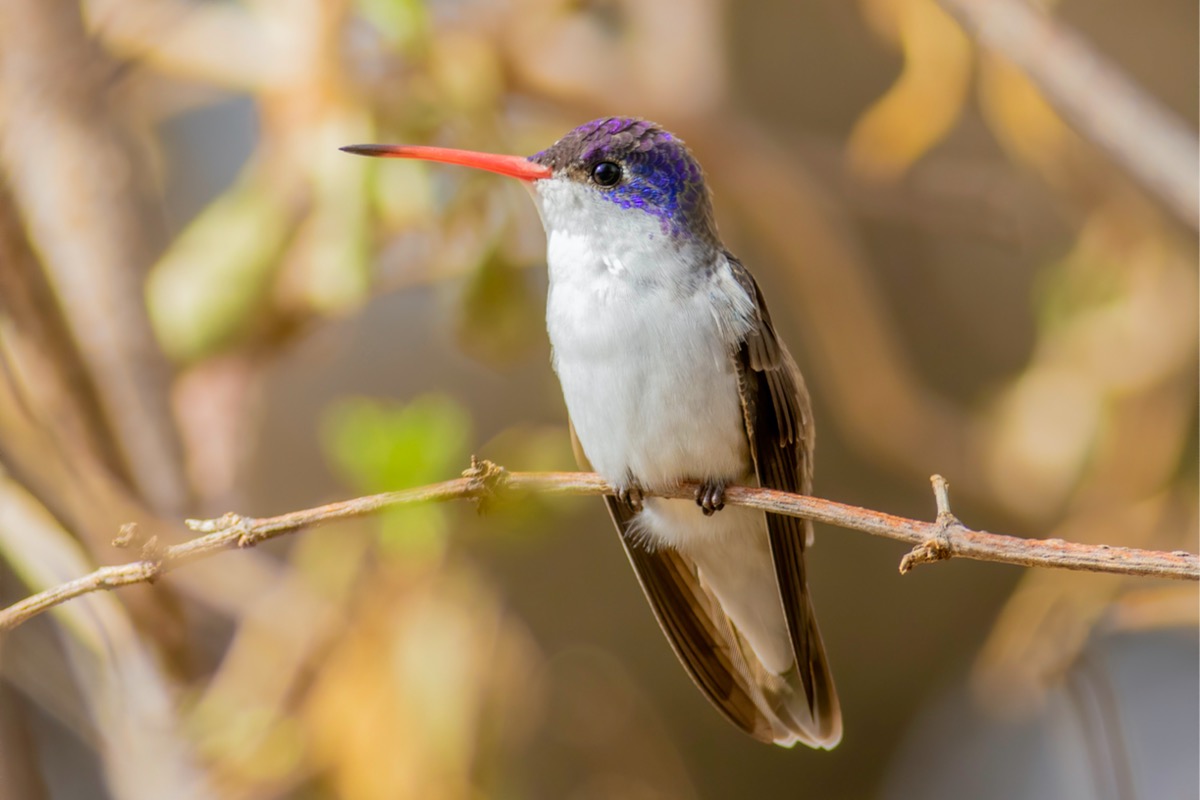
A newcomer to the United States, the 4½ -inch violet-crowned hummingbird can be seen in Southeast Arizona and extreme portions of Southwest New Mexico. Rather than noting it by its throat, identify this hummer by its iridescent violet crown and red-orange bill with a black tip. It has a white throat, greenish tail, iridescent shoulders, and a bronze-green back. At dawn during mating season, these hummers sing a squeaky song.
Key Characteristics: As the name suggests, the violet-crowned hummingbird is identifiable by its iridescent violet cap.
Habitat Range: When it ventures north of the Mexico border, the violet-crowned hummingbird can be found in Southeastern Arizona and some of Southwest New Mexico.
5. Calliope Hummingbird
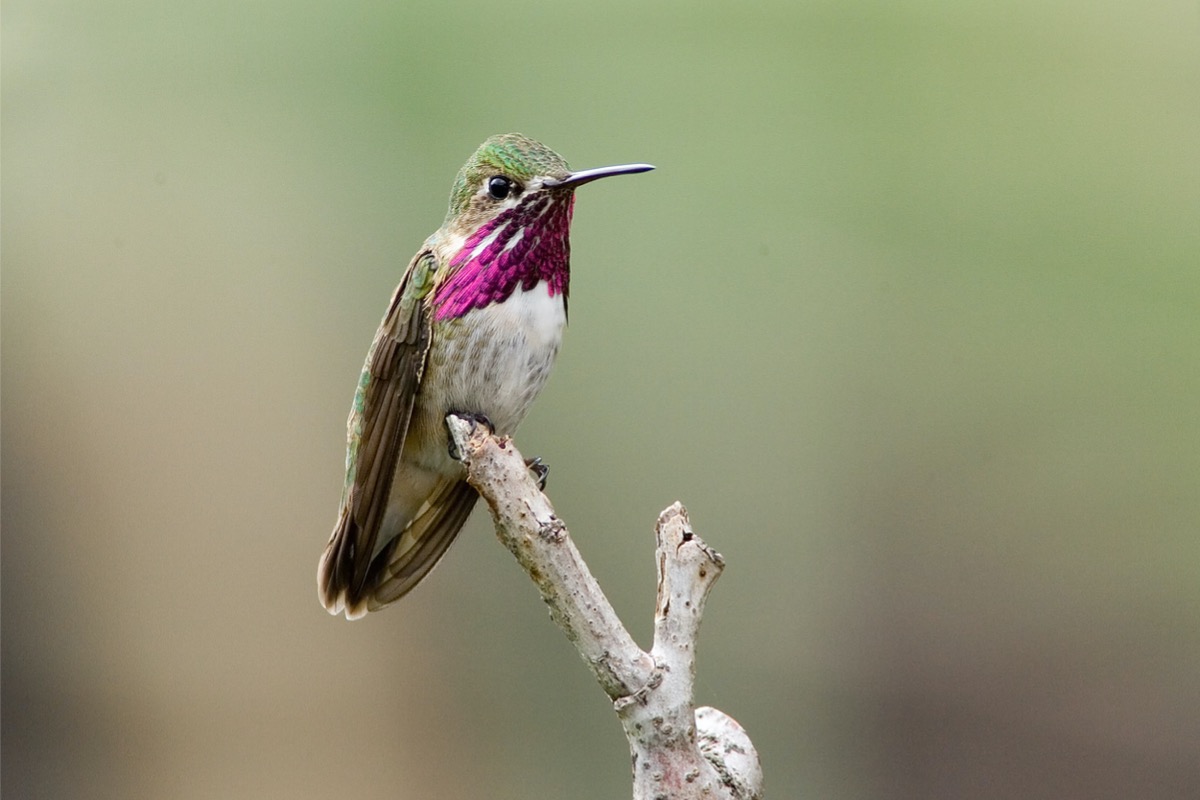
As the smallest bird in North America north of the Mexican border, the 3¼-inch calliope hummingbird is also the only hummer with a streaked throat. The male exhibits V-shaped magenta streaks on his gorget; the female displays some red. Both are green on their backs, with males wearing a green “vest” and females showing a peachy underside. Calliope hummingbirds have short bills and short tails.
Key Characteristics: This tiny hummer looks even smaller due to a hunched posture, but it’s most readily identified by the magenta-streaked gorget of the male.
Habitat Range: Calliope hummingbirds migrate from Central America, Mexico, and the Southwest U.S. in the winter up the California coast to British Columbia, where they breed in mountain meadows, open forests, and aspen thickets near streams.
6. Anna’s Hummingbird
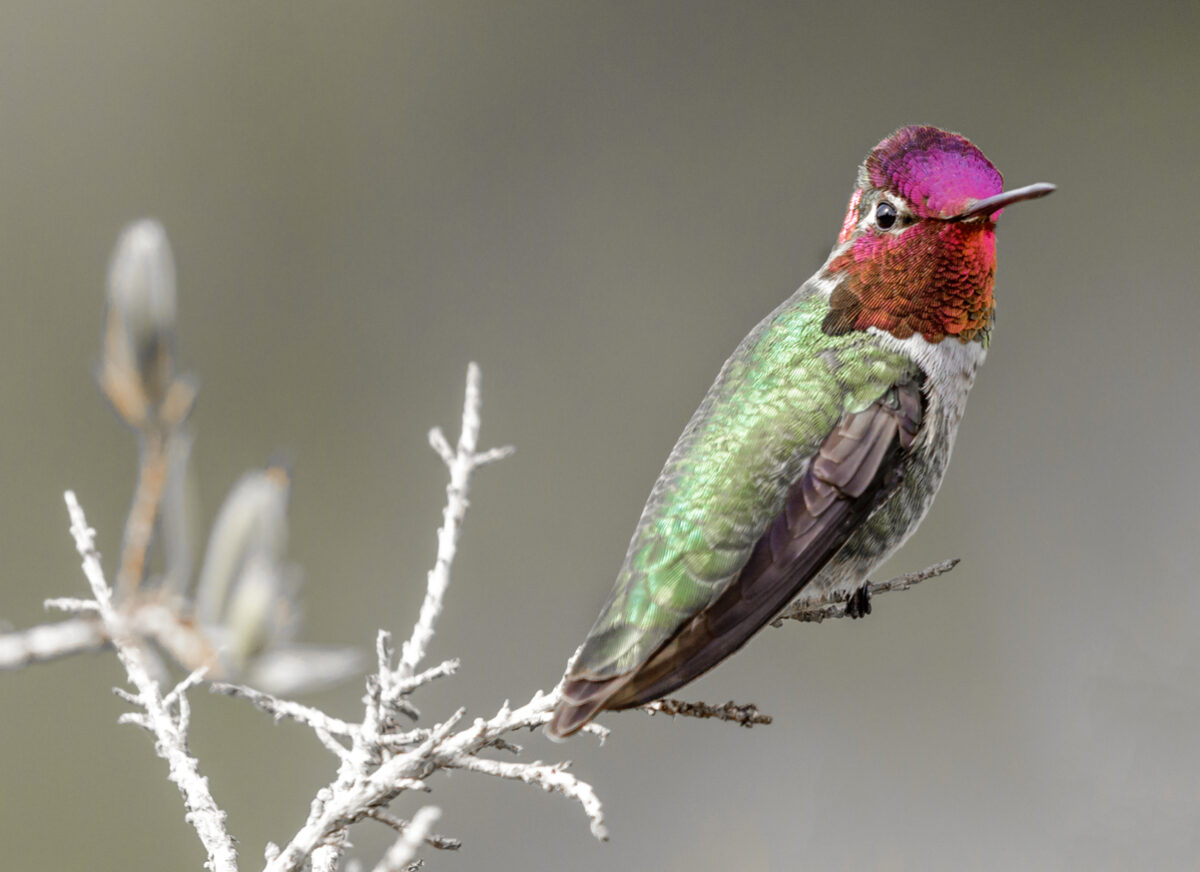
The only hummingbird with a red crown, Anna’s hummingbird also has the northernmost year-round range of any hummer. The body is predominantly green and gray without orange or rufous marks. Males have rosy-red heads and throats, with color extending to the sides of their necks. Females have green crowns and red flecks on their throats. Both have straight, short bills and broad tails.
When perched, the wingtips of Anna’s hummingbirds meet the tips of their tails. They often “chip” and “pip” when perched, and make a high-pitched raspy buzz. They are territorial and more carnivorous than other hummers.
Key Characteristics: Easily identified by its red crown, Anna’s hummingbirds have short straight bills and broad tails.
Habitat Range: They can be found year-round along the West Coast from Northern Baja California to Southern Canada, and as far east as Central Arizona, extreme Southern Nevada, Southeastern Utah, and West Texas. They’ve also been spotted in Southern Alaska, Saskatchewan, Florida, Louisiana, New York, and Newfoundland.
7. Blue-Throated Hummingbird
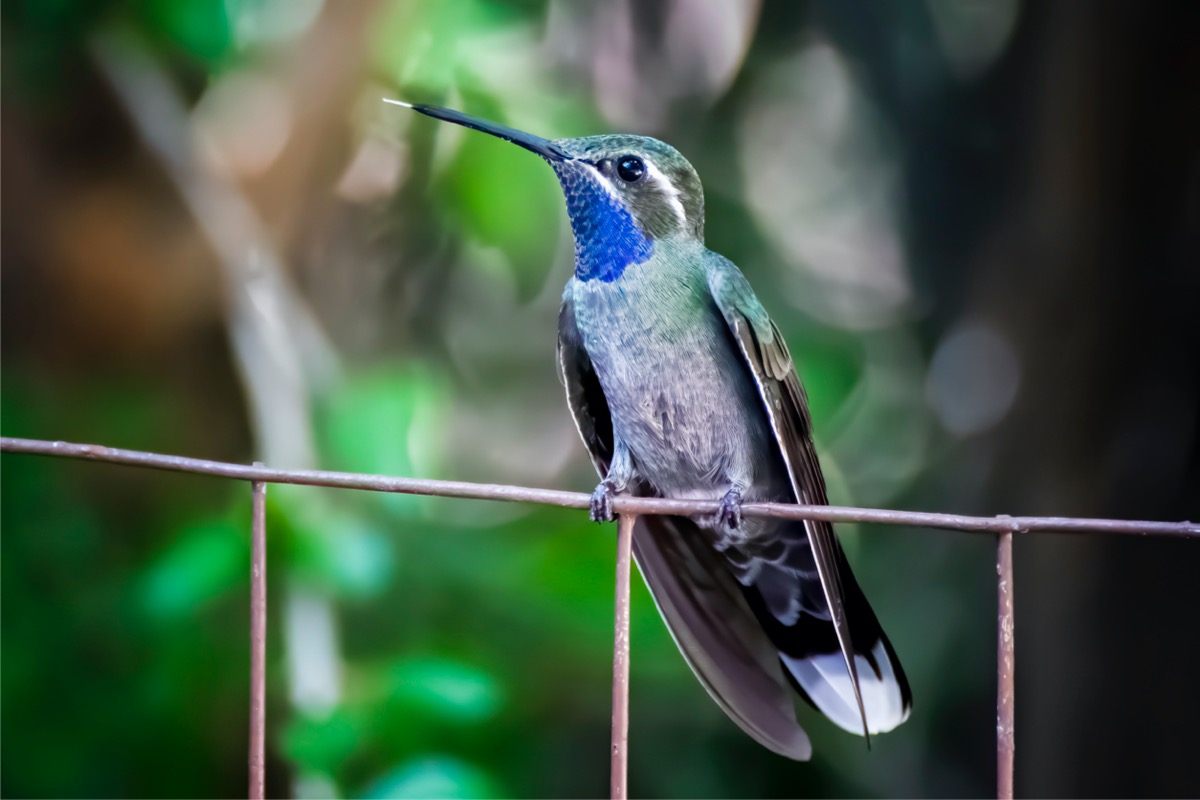
The largest of the North American hummers, the “blue-throated hummingbird” was renamed the blue-throated mountaingem in 2019 because it’s a member of the mountaingem genus, Lampornis. Both genders feature double white stripes on their faces, with gray underparts. Males have a bright, iridescent sapphire-colored gorget; females have a gray throat. Both sexes sing complex songs, often in duet during courtship. They can be aggressive at feeders.
RELATED: The Best Bird Feeders, Tested and Reviewed
Key Characteristics: The blue-throated mountaingem can be identified by its larger size and—in males—a bold blue gorget.
Habitat Range: They barely cross the Mexico border, reaching Southeastern Arizona, New Mexico, and Texas, preferring canyon streams and flower banks.
8. Plain-Capped Starthroat
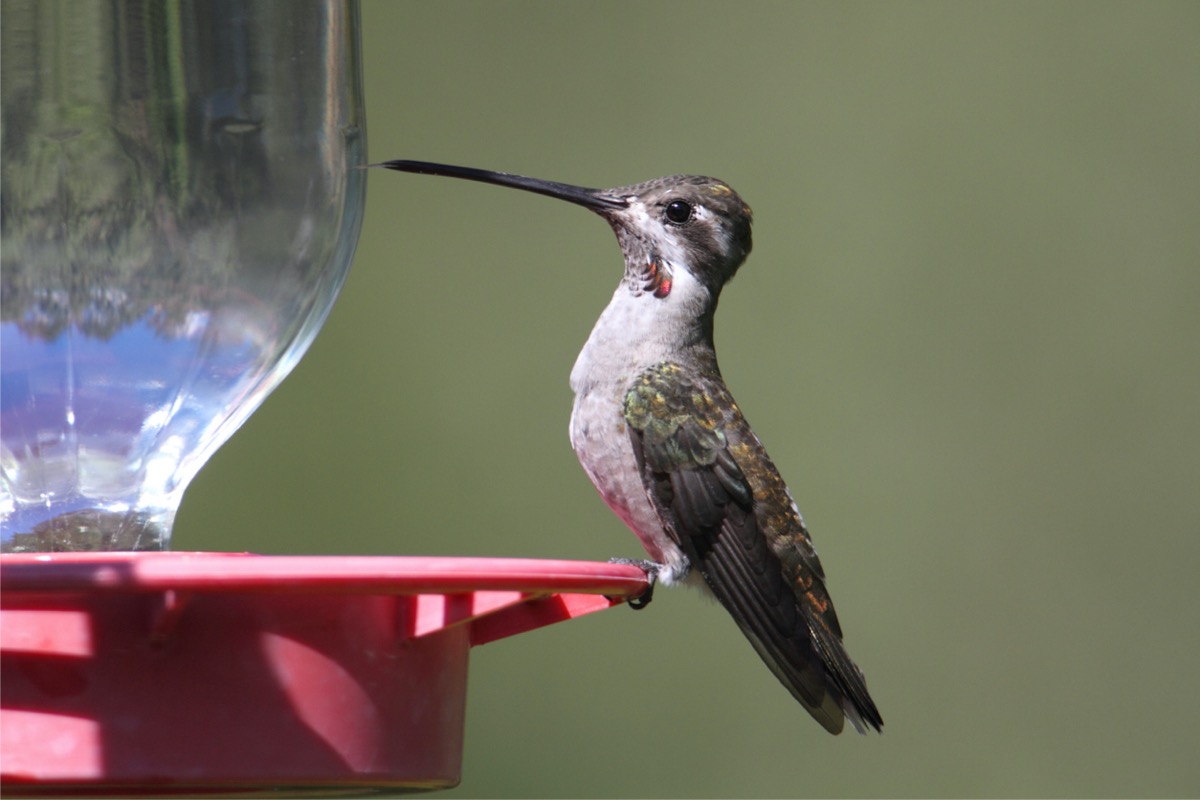
Another mountaingem genus member, plain-capped starthroats are native to the dry forests in Mexico and Central America, only occasionally wandering into Arizona. It’s a medium-size hummer with a very long, straight bill. Both genders look similar, with an iridescent bronze-green back and head, a white face with black eye stripes, pale gray underparts, and a slightly notched bronze-green tail with white-tipped black terminal band. They tend to prefer insects to nectar.
Key Characteristics: The long bill and eye stripes are the most striking features of the plain-capped starthroat.
Habitat Range: Common in lowland areas near streams, open lower areas of canyons, and the dry forest in Mexico and Central America, they only rarely venture to Arizona.
9. Magnificent Hummingbird
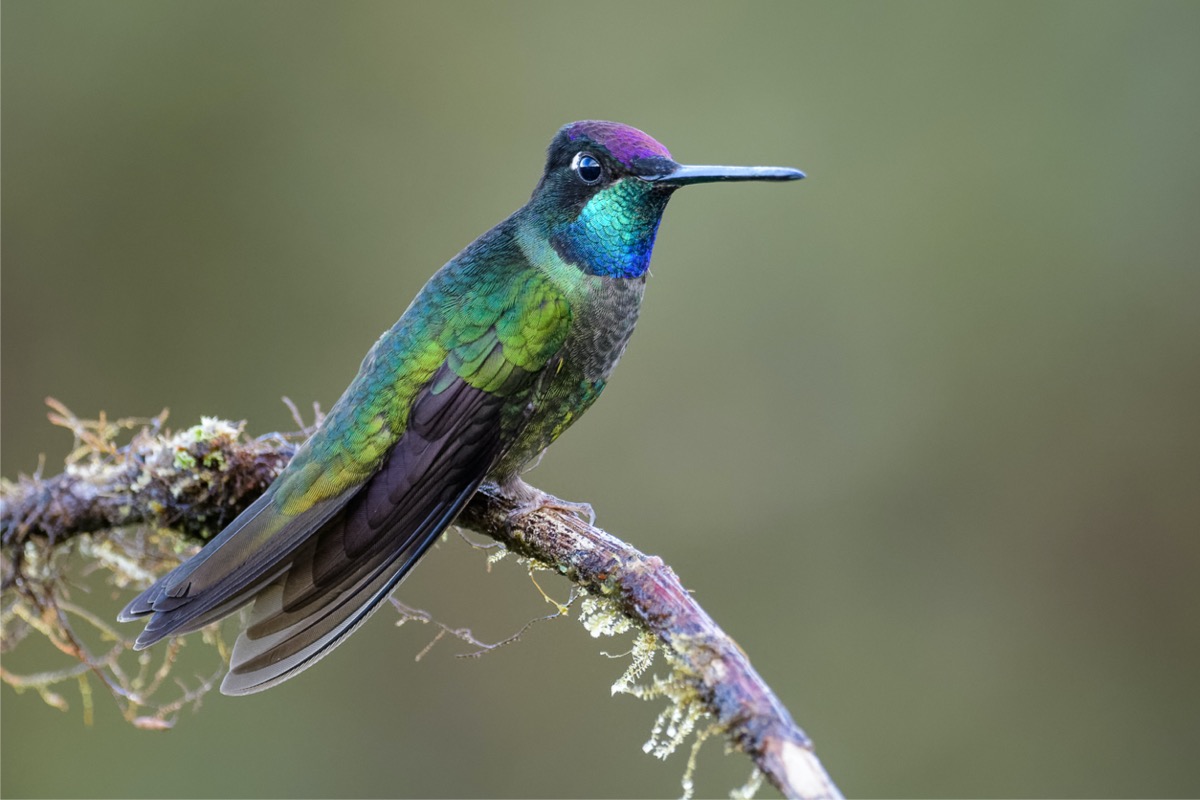
The magnificent hummingbird, or refulgent hummingbird, was formerly known as Rivoli’s hummingbird. The second-largest hummer north of Mexico at 4½ to 5½ inches, the magnificent hummingbird is considered friendly because it often stays close to humans within its feeding habitat. Males have stunningly iridescent bright blue-green gorgets with a glossy bronze-green chest and upperparts. Their heads are black with a violet crown.
Females have bronze-green upperparts and dull gray underparts, with faint streaking on gray throats. Both have white stripes behind their eyes. They can be territorial and aggressive.
Key Characteristics: Identifiable by their larger size and the male’s brilliant blue-green throats, the magnificent hummingbird isn’t shy around humans.
Habitat Range: They breed in mountainous regions of Southeastern Arizona and Southwest New Mexico, and have occasionally been observed in other states and as far north as Kansas, Minnesota, and Wyoming. They winter in Mexico and Central America.
10. Costa’s Hummingbird

At 3½ inches, Costa’s hummingbird is one of the smaller hummingbird varieties. Males have a bright, iridescent, deep violet-purple head and gorget, which extends down the sides of their necks. Their backs are green, underparts are pale gray with dull green flanks, and legs and feet are black. Females have white throats and underparts. Males produce a thin, high-pitched whistle.
Key Characteristics: The vibrant purple-violet head and gorget of Costa’s hummingbird stands out, especially against their black legs, feet, and bill.
Habitat Range: As pollinators of cacti, they’re found in desert washes and dry chaparral from Central California to Southern Nevada, Southwestern Utah, Arizona, and Baja California.
RELATED: Solved! How to Keep Ants Out of Hummingbird Feeders
11. Berylline Hummingbird

Sightings north of the Mexican border are rare, but the berylline hummingbird is easy to spot when it’s in the U.S., thanks to a bright metallic olive-green head and rufous wings and rump. The tail and primary wings are also rufous and are slightly forked. Its underparts are gray. The male’s bill is straight and narrow, black on top and red-orange below. Berylline hummingbirds are about 4¼ inches long.
Key Characteristics: This hummer is on the large side, and is distinguishable by its bright metallic green head.
Habitat Range: They breed in thickets in Mexico and Central America, and occasionally travel to Southeastern Arizona.
12. White-Eared Hummingbird
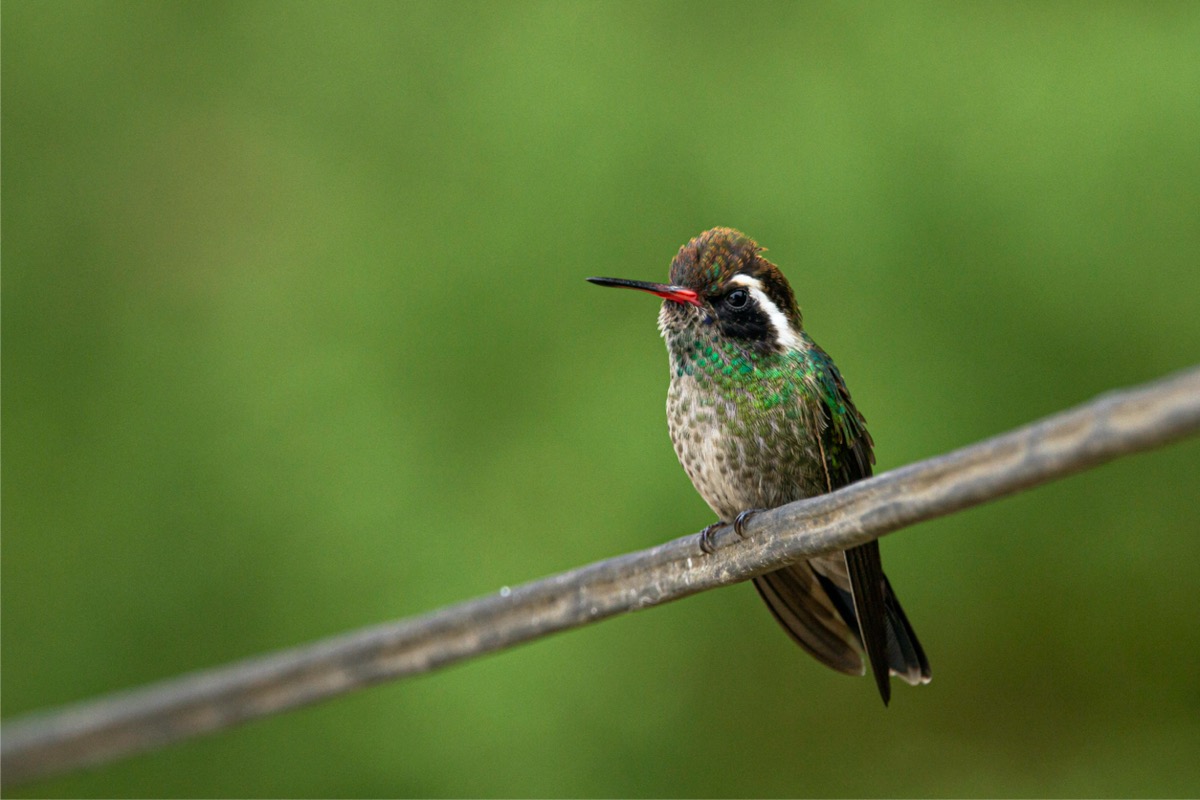
This stocky, medium-sized (3¾ inches) hummer frequents the mountains of the U.S. Southwest. It’s the only hummingbird with a combination of a long white stripe behind the eye, red-orange bill with black tip, and violet crown. Both genders display a black bask and the thick white ear stripe for which they’re named. The male’s head and throat feature violet and green on a black background. Females have a pale throat and green-spotted breast. Their tails are square.
Key Characteristics: The white stripe on the face of the white-eared hummingbird clearly identifies it, although the violet crown and red-orange bill provide confirmation.
Habitat Range: Found in the high mountain forests of Mexico, white-ears sometimes visit canyons in the U.S. Southwest and very rarely Southeastern Arizona, Southwest New Mexico, and Texas.
13. Green Violet-Ear
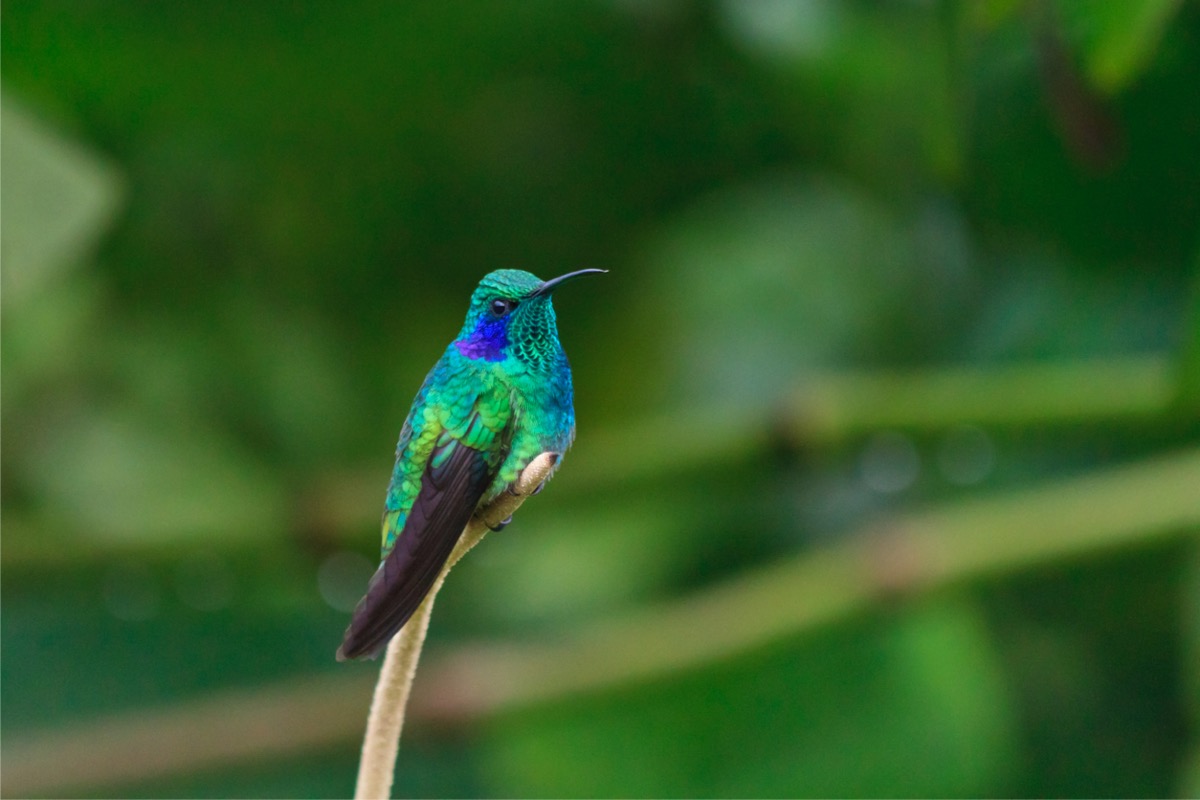
Also known as Mexican violet-ears, the green violet-ear hummingbird is recognized by its overall deep green iridescent plumage contrasted by dark violet cheeks and breast patches. They have a broad, slightly notched dark blue tail band. The northern subspecies has a large violet central breast spot and violet-blue band along the chin (the “ear”), while the subspecies from Costa Rica and south lacks the violet breast spot. Females are a bit smaller than the 4½-inch male, with a narrower violet chin band and slightly duller plumage. They sing a jerky chipping song.
Key Characteristics: Bright violet-purple cheeks on a brilliant green body indicate the green violet-ear hummingbird.
Habitat Range: They reside primarily in the highlands of South-Central Mexico to Central America, and they even reach as far as the Andes Mountains in northern Venezuela and Bolivia. They’re occasionally observed in Southern California and across the U.S. Southwest and South.
14. Xantus’s Hummingbird
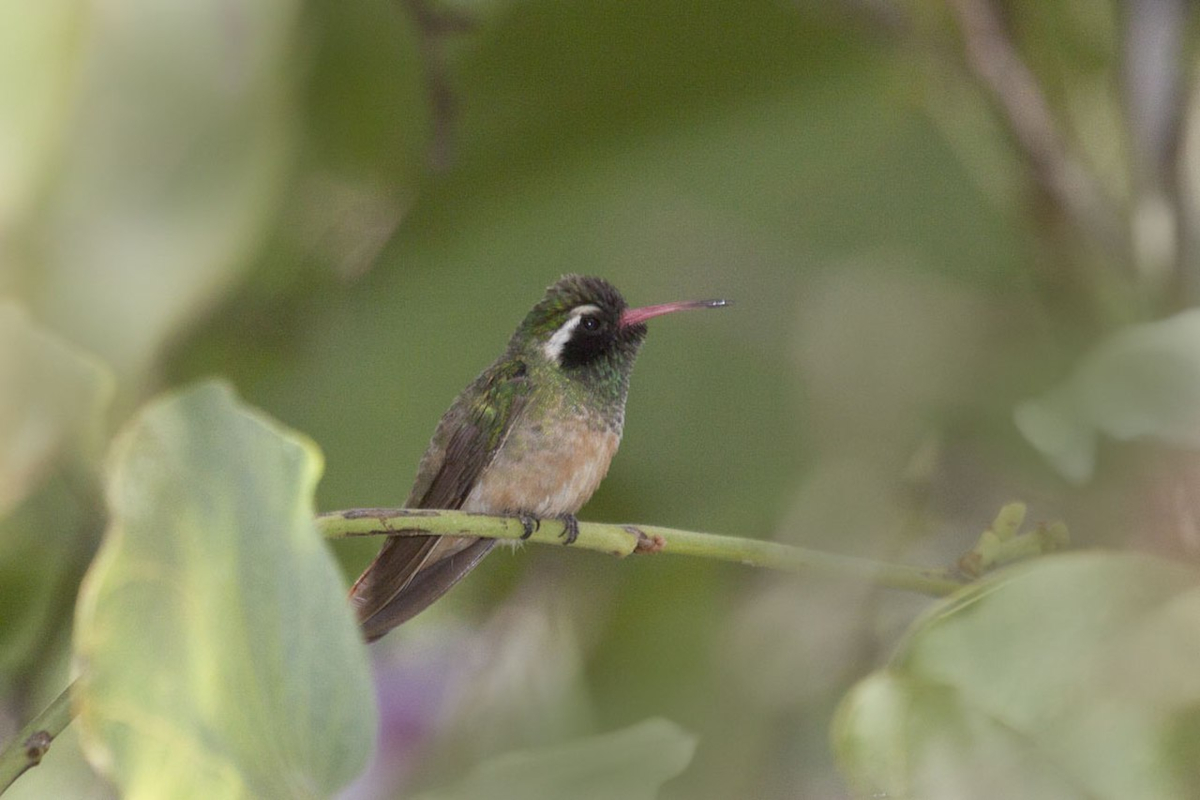
The medium-size (3 to 3½ inches) Xantus’s hummingbird is endemic to the southern part of the Baja California peninsula. They’re mostly green on their backs and upper parts, while their tails are dark red-brown with faint black tips and two green inner rectrices.
Like the white-eared hummingbird to whom they’re related, both genders feature a white eye stripe contrasted by a black stripe on the lower side. Males have iridescent green throats. Their bills are slightly curved and reddish with a black tip, and they have a green crown.
Key Characteristics: Look for a slightly curved bill and the white eye stripe above a black stripe. Their bodies are mostly green and males have green throats.
Habitat Range: Xantus’s hummingbirds are endemic to the southern portion of Baja California.
RELATED: How to Attract Birds to Feeders: 13 Simple Strategies That Work
15. Rivoli’s Hummingbird
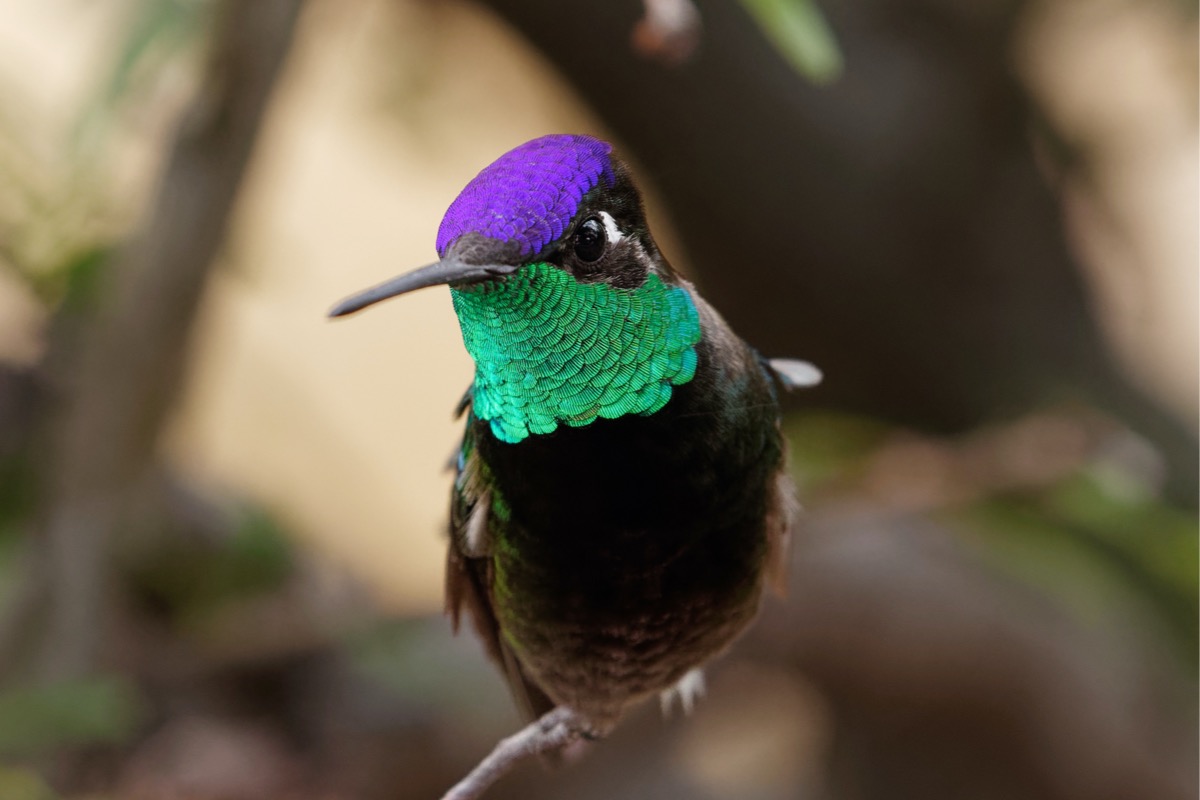
Until 1983, Rivoli’s hummingbird was known as the magnificent hummingbird. In 2017, the magnificent hummingbird was divided into two species, which returned the name Rivoli to the species living between the U.S. and Nicaragua. At 5¼ inches, it’s the second-largest hummer in Mexico. It features a long bill, flat head, and large tail. Males display a green throat and violet-blue-purple crown. Females have green upperparts, gray underparts, and a white streak that extends behind the eyes.
Key Characteristics: Their large size is the first indicator of their identity, although the telltale green throat, violet crown, and white spot behind the eye also give away the Rivoli’s hummingbird’s identity.
Habitat Range: Rivoli’s hummingbirds prefer mountainous forests and shady canyons found from Nicaragua to the extreme U.S. Southwest.
16. Lucifer Hummingbird
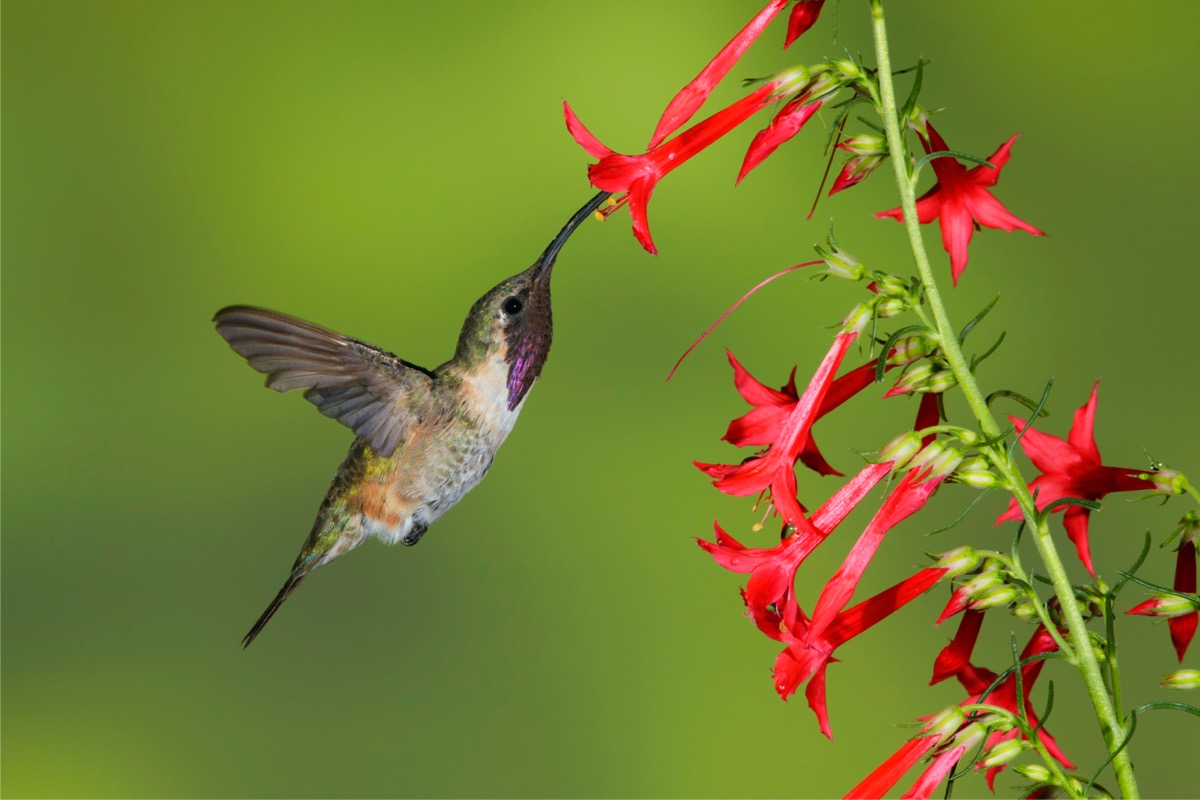
The small (3½ inches) lucifer hummingbird is the only hummingbird with a decurved, downward-arching bill. The bright purple-throated hummer belongs to a hummingbird species called “sheartails” because of its deeply forked, narrow tail. Males have a green crown and long tail. Females have a whitish belly and rounded tail. They prefer arid climates—desertlike with dry slopes and scattered vegetation.
Key Characteristics: The vivid purple throat may be the first thing to get attention, but lucifer hummingbirds also have long, forked tails and downward-curving bills. Males have green crowns.
Habitat Range: Native to Northern and Central Mexico, the lucifer hummingbird sometimes comes to extreme Southern Arizona, Southwest New Mexico, and West Texas.
17. Rufous Hummingbird
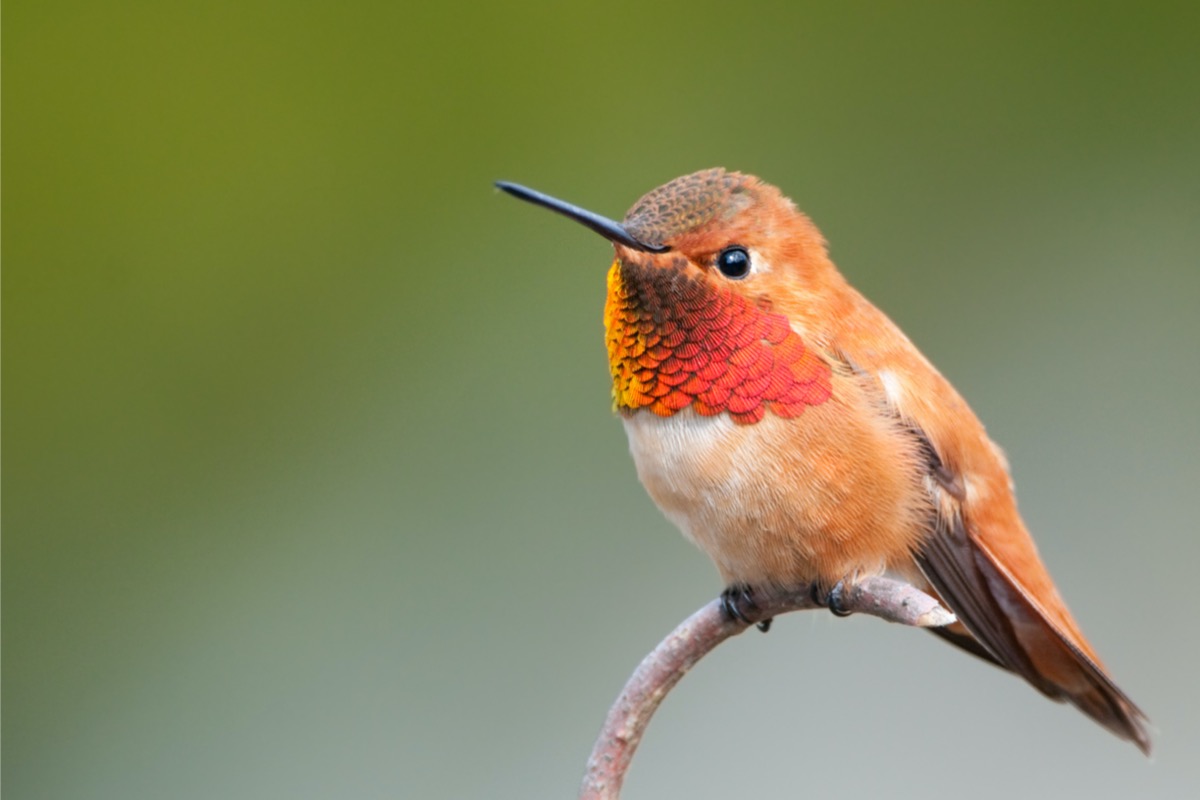
As the only North American hummingbird with a rufous back, the rufous hummingbird is aptly named, although some call it the yellow hummingbird. At 3½ inches, this medium-size hummer is considered the most aggressive and fiercely territorial over habitat and food. Both genders are rufous all over, with straight, medium-length black bills, and tails that taper to a point when folded. Males have an orange-red gorget. Females have green above rufous flanks, rufous patches in a green tail, and a spot of red-orange on their throats.
Key Characteristics: The name says it all: this hummer is rufous (reddish brown) all over. Medium-size hummingbirds with a straight, black bill, they are easily spotted due to their bright chestnut color.
Habitat Range: They migrate through the Pacific states to breed in Southern Alaska, Western Canada, and U.S. Pacific Northwest, then return to Mexico through the Rocky Mountains.
18. Buff-Bellied Hummingbird
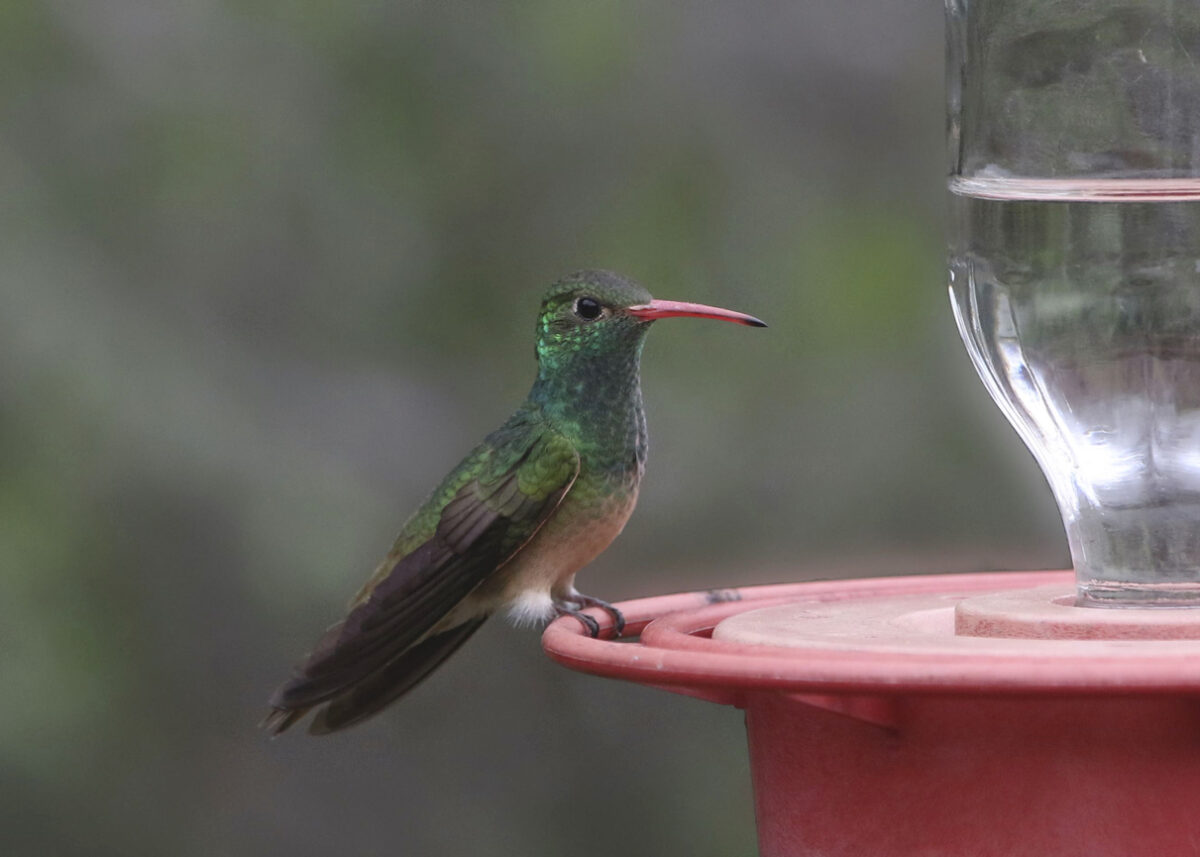
The only hummingbird to regularly nest in South Texas, the buff-bellied hummingbird is only partially migratory and often winters along the Gulf Coast. A larger hummer at 4¼ inches long, it features metallic olive-green above, a buff belly, and a rufous, slightly forked tail. Underwings are white. Males have a straight, very slender bill that’s red with a dark tip. They also have a metallic green gorget. Females are similarly colored but not as bright, and they have a darker upper bill.
Key Characteristics: Distinctive metallic olive-green plumage, buff belly, and a rufous, slightly forked tail help identify the buff-bellied hummingbird.
Habitat Range: They are often found in South Texas along the Gulf Coast, especially in thickets and wood margins.
19. Cinnamon Hummingbird

Named for its completely cinnamon-colored underparts, the cinnamon hummingbird is sometimes confused with the buff-bellied or rufous-tailed hummers. The upperparts on this 3½ to 4½-inch bird are metallic bronze and green; its chin and upper throat are paler rufous-cinnamon and its tail is deep cinnamon-rufous-chestnut. Males have a bright red bill tipped in black, while females have a mostly black bill with a red base. Its song is described as varied, high, thin, slightly squeaky chips, while its call is a buzzy, scratchy tzip.
Key Characteristics: The cinnamon hummingbird has distinctive, completely cinnamon underparts and metallic bronze and green upperparts, with a rufous throat.
Habitat Range: Cinnamon hummingbirds prefers dry tropical lowlands, scrubby woodland, gardens, and semi-open areas with flowering trees in Northwestern Mexico to Costa Rica.
20. Bumblebee Hummingbird
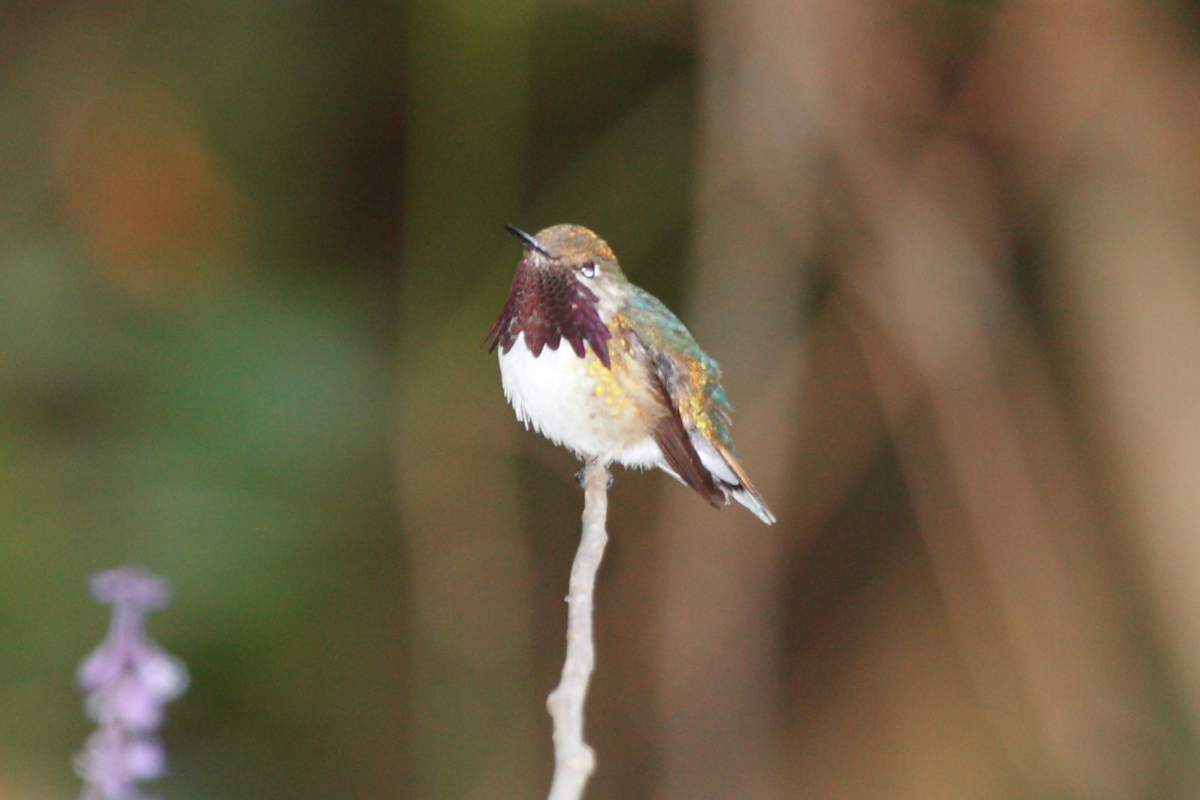
Under 3 inches long, the bumblebee hummingbird is arguably one of the smallest birds in North America. Its name derives from the insect of similar size that creates a buzz much like that of the hummer’s wings, along with sharing the same kind of erratic flight to avoid predators. Both genders feature metallic bronze-green upperparts and a white breast and chest.
Males have a magenta gorget, with flared feathers, while females have a spotted white throat. Both have short, rounded tails and short black bills. Their call is a high “chip.” They feed while hovering in a horizontal position with their tails cocked.
Key Characteristics: These tiny hummers have an iridescent bronze-green upperpart with a white chest. Males exhibit a magenta gorget.
Habitat Range: Bumblebee hummingbirds prefer shrubby clearings and edges in the montane forests of pine and oak in Mexico, but can sometimes be seen in Southern Arizona.
RELATED: How to Clean Bird Feeders to Keep Your Feathered Friends Safe
21. Amethyst-Throated Mountaingem
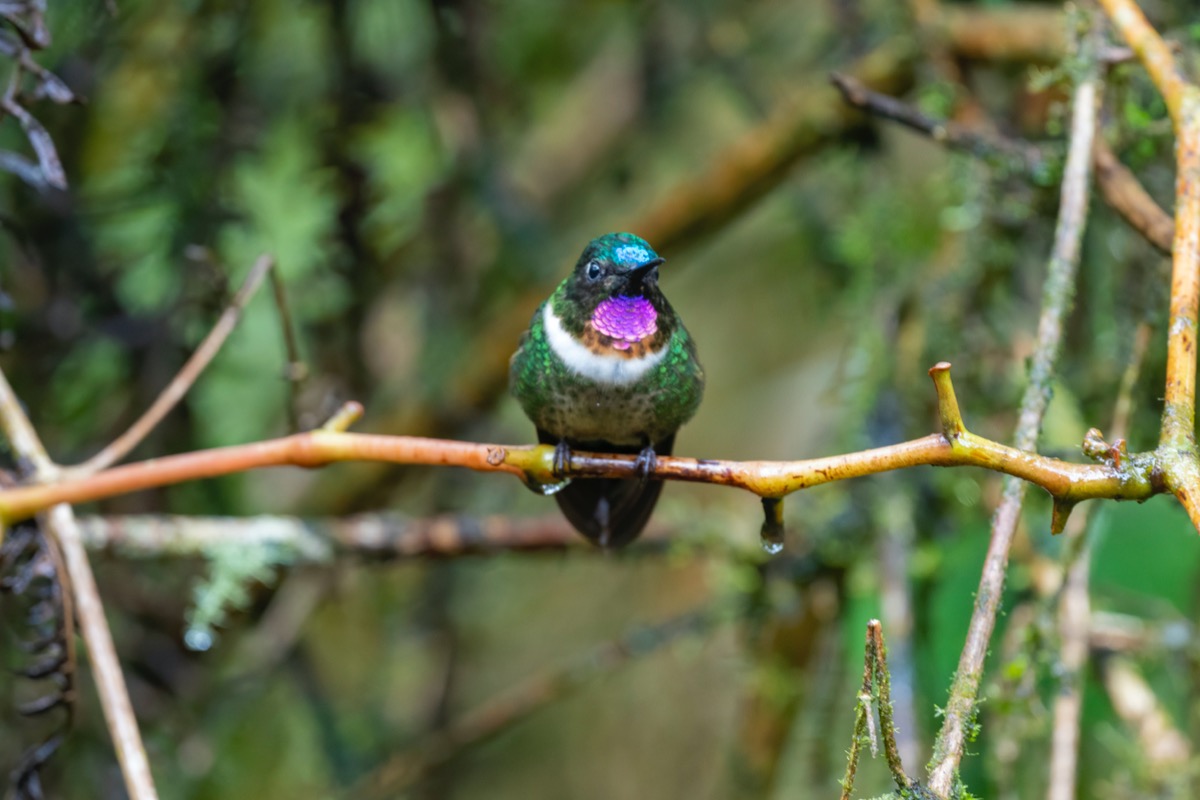
It’s easy to detect the amethyst-throated mountaingem due to its bright rosy-pink gorget. Both genders have a medium-length black bill that’s straight, a white stripe behind the eye, dark cheek feathers, and a broad, slightly forked tail that is black with gray tips. Males have a dark green crown, a bronze rump and black uppertail outer feathers, with a dusky gray breast and belly. Females have similar coloring, except for a cinnamon throat. This large variety (4½ to 5 inches) is endemic to Mexico. Frequently seen in Central America, it does not migrate to the U.S.
Key Characteristics: The vibrant, iridescent amethyst-colored gorget makes this hummer stand out—as does its larger size. It has a dark forked tail, a black bill, and gray plumage that makes the male’s green crown stand out.
Habitat Range: Endemic to Mexico, the amethyst-throated mountaingem is also found in Guatemala, Honduras, and El Salvador, where it prefers a subtropical or tropical montane forest.
22. Broad-Billed Hummingbird
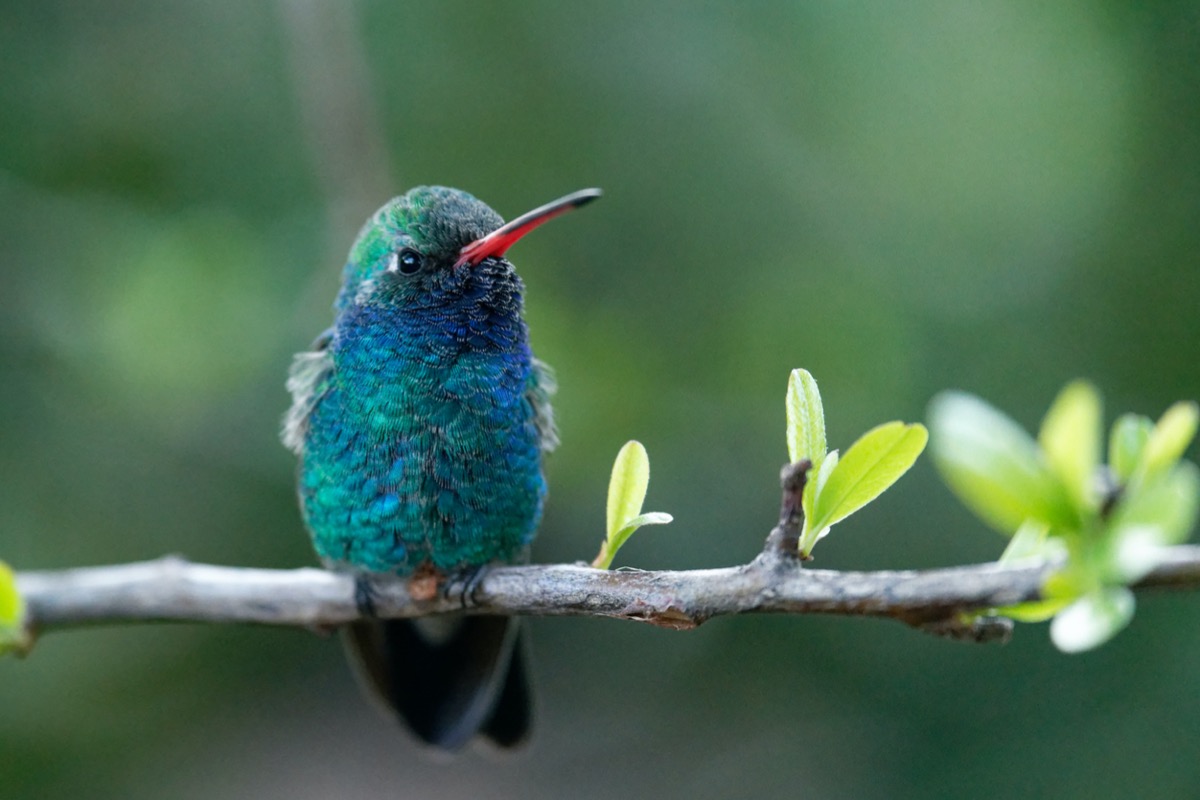
A smaller hummingbird at 3¾ inches, the broad-billed hummingbird displays a long, straight red-orange bill and a blue-green chin and throat. Males are a rich, deep green with white undertail coverts and shimmering blue gorgets. Females are gold-green above and gray below, with a white line behind the eye. Males also have fuller tails than females, whose tails have squared corners.
Key Characteristics: The dazzling blue gorget and long red-orange bill identify the colorful little broad-billed hummingbird.
Habitat Range: They like to nest near stream canyons in mountainous areas of Mexico, Arizona, and New Mexico.
23. Green-Breasted Mango
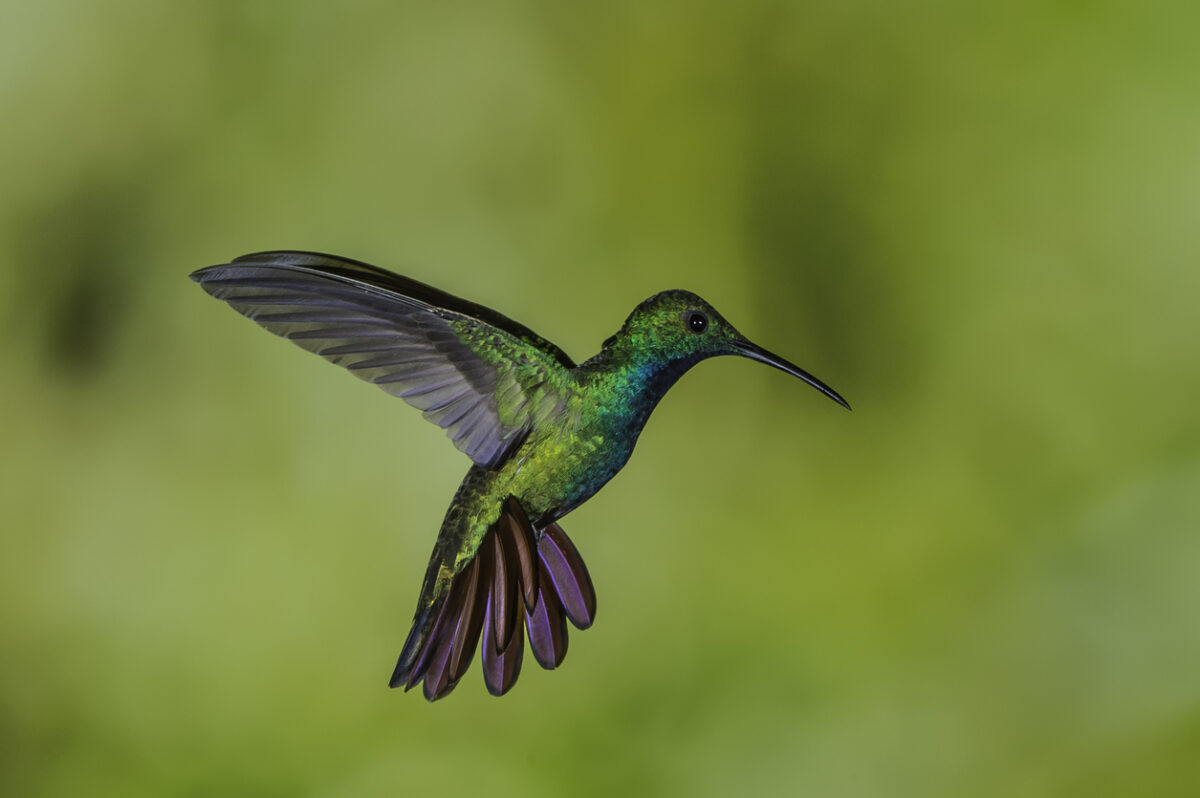
A larger hummingbird at 4¾ inches, the green-breasted mango has a slightly curved bill and deep magenta to purple-wine outer tail feathers tipped in black. Outer tail feathers on females are broadly banded in magenta and iridescent dark blue, and feature narrow white tips. Males have vibrant bright green upperparts, with a matte black throat and chest bordered in blue-green, and bright green flanks. Females have bronze-green upperparts and white underparts with a dark stripe changing from black at the chin to blue-green on the throat.
Key Characteristics: One of the bigger hummingbird varieties, the green-breasted mango is colorful, with green upperparts and magenta outer tail feathers.
Habitat Range: The green-breasted mango prefers forest edges and clearings in tropical lowlands from Eastern Mexico to northern parts of South America. Extremely rarely, they can be sighted in Texas.
